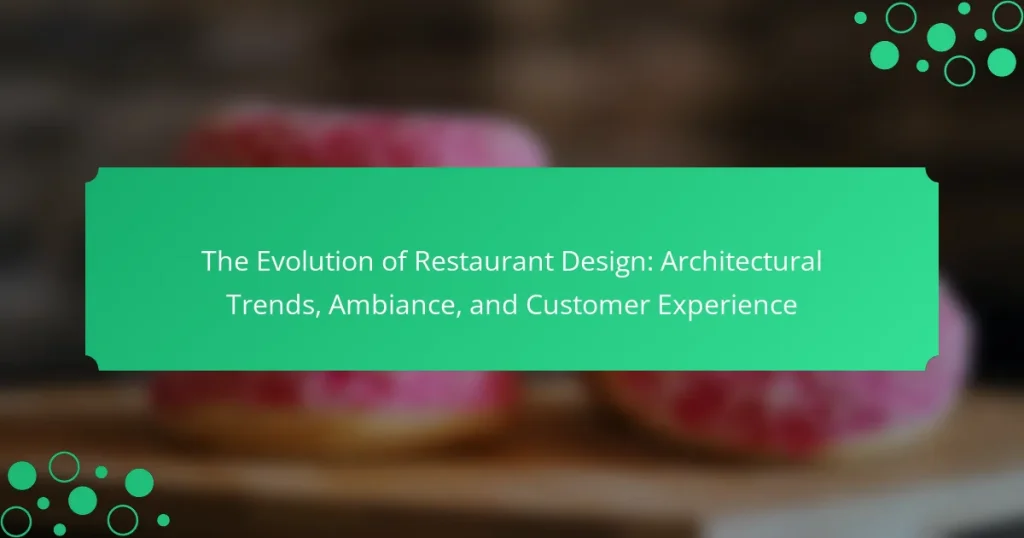The article examines the evolution of restaurant design, highlighting how architectural trends, ambiance, and customer experience have transformed over time. It outlines the progression from functional dining spaces to ornate designs influenced by European styles in the late 19th century, followed by the modernist movement of the mid-20th century that prioritized minimalism. The rise of themed restaurants in the 1980s introduced immersive experiences, while the 21st century emphasized sustainability and technology integration. These developments illustrate the dynamic relationship between restaurant design and changing societal trends, reflecting consumer preferences and cultural shifts.

What is the Evolution of Restaurant Design?
The evolution of restaurant design reflects changing societal trends and consumer preferences. Initially, restaurants were simple dining spaces focused on functionality. In the late 19th century, ornate designs emerged, influenced by European styles. The mid-20th century introduced modernism, emphasizing minimalism and open spaces.
By the 1980s, themed restaurants gained popularity, creating immersive dining experiences. The 21st century saw a focus on sustainability, with eco-friendly materials and designs. Technology integration also became essential, enhancing customer interaction. These trends demonstrate how restaurant design adapts to cultural shifts and consumer demands.
How has restaurant design changed over the decades?
Restaurant design has evolved significantly over the decades. In the 1950s, diners featured simple layouts and vibrant colors. The 1970s introduced more thematic designs, often reflecting cultural trends. By the 1980s, fine dining emphasized elegance with upscale materials and sophisticated ambiance. The 1990s saw a rise in open kitchens, enhancing transparency and interaction. In the 2000s, sustainability became a focus, incorporating eco-friendly materials and practices. Today, technology integration is prominent, with digital menus and smart ordering systems. Each decade reflects changing consumer preferences and societal influences on dining experiences.
What are the key historical milestones in restaurant design evolution?
The key historical milestones in restaurant design evolution include the establishment of the first modern restaurants in the 18th century. In 1765, the first restaurant as we know it opened in Paris, offering a menu with individual dishes. This marked a shift from taverns and inns that served only set meals.
In the 19th century, the introduction of the café culture in Europe transformed dining into a social experience. The art nouveau movement in the late 1800s influenced restaurant interiors, emphasizing aesthetics and comfort.
The mid-20th century saw the rise of fast food chains, prioritizing efficiency and standardized design. This revolutionized how restaurants operated and catered to mass consumerism.
In the late 20th century, the trend shifted towards unique, themed dining experiences. This era emphasized ambiance and customer experience, leading to the popularity of designer restaurants.
Today, sustainable design and technology integration are key trends in restaurant design. These advancements reflect a growing awareness of environmental impact and customer engagement.
How do cultural influences shape restaurant design trends?
Cultural influences significantly shape restaurant design trends by dictating aesthetic preferences and functional layouts. For example, Asian-inspired restaurants often utilize natural materials and open spaces to reflect harmony with nature. In contrast, Mediterranean designs may incorporate vibrant colors and communal seating to encourage social interaction.
Cultural heritage informs the choice of decor, furnishings, and even menu presentation. For instance, Mexican restaurants frequently feature bold colors and traditional art to evoke a sense of place. Similarly, American diners often showcase retro elements to evoke nostalgia.
Moreover, cultural influences affect the use of technology in restaurant design. Modern establishments may integrate digital menus or interactive elements that resonate with tech-savvy cultures.
Research shows that restaurants reflecting local culture tend to attract more customers. A study published in the Journal of Hospitality and Tourism Research found that culturally authentic designs enhance customer satisfaction and loyalty.
What are the main architectural trends in restaurant design today?
The main architectural trends in restaurant design today include sustainability, open layouts, and technology integration. Sustainability focuses on using eco-friendly materials and energy-efficient systems. Open layouts promote a sense of community and transparency. Technology integration enhances customer experience through digital menus and contactless payments. Biophilic design, which incorporates natural elements, is also gaining popularity. The trend towards multifunctional spaces allows restaurants to serve multiple purposes. Adaptive reuse of existing buildings is another significant trend, preserving history while modernizing functionality. These trends reflect changing consumer preferences and enhance the dining experience.
What role does sustainability play in modern restaurant architecture?
Sustainability plays a crucial role in modern restaurant architecture by promoting environmental responsibility. Restaurants increasingly incorporate eco-friendly materials and energy-efficient systems. This approach reduces their carbon footprint and operational costs. For instance, using reclaimed wood and recycled materials minimizes waste. Additionally, energy-efficient appliances decrease energy consumption significantly. According to the U.S. Green Building Council, green buildings can save up to 30% on energy costs. Furthermore, sustainable design enhances the dining experience. Natural lighting and green spaces create a pleasant atmosphere for customers. Overall, sustainable practices in restaurant architecture align with growing consumer demand for eco-conscious dining options.
How does technology influence contemporary restaurant design?
Technology significantly influences contemporary restaurant design by enhancing efficiency and customer experience. Smart kitchen equipment streamlines food preparation, reducing wait times. Digital menus and ordering systems improve service speed and accuracy. Mobile payment solutions offer convenience and security for customers. Automated inventory management systems help reduce food waste and optimize stock levels. Energy-efficient appliances contribute to sustainability in restaurant operations. Advanced lighting and sound systems create customizable atmospheres for varied dining experiences. Overall, technology integrates functionality with aesthetic appeal in modern restaurant spaces.
What are the essential elements of restaurant ambiance?
The essential elements of restaurant ambiance include lighting, decor, music, and spatial arrangement. Lighting sets the mood and can affect diners’ emotions. Warm lighting creates a cozy atmosphere, while bright lighting can energize the space. Decor contributes to the overall theme and aesthetic appeal of the restaurant. It includes artwork, furniture, and color schemes. Music influences the dining experience by affecting the pace of service and customer mood. The right selection can enhance enjoyment, while inappropriate choices can detract from it. Spatial arrangement impacts the comfort and flow within the restaurant. Well-designed layouts promote interaction and ease of movement. Each of these elements plays a crucial role in shaping the overall dining experience.
How do lighting and color schemes affect customer experience?
Lighting and color schemes significantly affect customer experience by influencing mood and perceptions. Bright lighting can create an energetic atmosphere, while dim lighting often promotes relaxation. Studies show that color can impact emotions; for example, warm colors like red can stimulate appetite. Conversely, cooler colors like blue can create a calming effect. Research from the Journal of Environmental Psychology indicates that well-designed lighting enhances customer satisfaction. Additionally, color schemes can influence purchasing behavior, as certain colors can encourage spending. Overall, effective lighting and color choices are essential for creating a desirable dining experience.
What types of seating arrangements enhance the dining experience?
Flexible seating arrangements enhance the dining experience. These arrangements allow for adaptability based on group size and occasion. Communal tables promote social interaction among diners. They create a sense of community and shared experience. Booth seating offers privacy and comfort, enhancing intimate dining moments. Banquet seating accommodates larger groups, ideal for celebrations. Outdoor seating provides a unique ambiance, connecting diners with nature. Research shows that diverse seating options can increase customer satisfaction and return visits. A study by the Cornell University School of Hotel Administration found that seating layout significantly influences diners’ perceptions of the restaurant experience.
How do architectural trends impact customer experience?
Architectural trends significantly impact customer experience by shaping the environment in which customers interact. Design elements such as layout, lighting, and materials influence comfort and functionality. For example, open floor plans promote social interaction, enhancing the dining experience. Incorporating natural elements, like plants and natural light, can improve customer mood and satisfaction. Research shows that aesthetically pleasing environments can increase customer dwell time and spending. A study by the Cornell University School of Hotel Administration found that restaurant design affects customers’ perceptions of food quality and service. Therefore, architectural trends are crucial in creating positive customer experiences in restaurants.
What factors contribute to creating a memorable dining atmosphere?
Lighting plays a crucial role in creating a memorable dining atmosphere. It influences mood and perception. Soft, warm lighting can enhance intimacy. Bright lighting may encourage a lively environment.
Acoustic elements also significantly impact the dining experience. Background music and sound levels shape guest interactions. A well-designed space minimizes noise distractions. This contributes to a comfortable ambiance.
Interior design elements are vital as well. Color schemes, furniture, and layout affect guest comfort. Unique decor can create a memorable visual experience. Thematic designs often enhance the overall atmosphere.
Service quality is another key factor. Attentive and friendly staff improve guest satisfaction. Personalized service can make the dining experience unforgettable.
Overall, these factors work together to craft an engaging and memorable dining environment.
What specific design elements enhance customer satisfaction?
Specific design elements that enhance customer satisfaction include layout, lighting, color schemes, and furniture comfort. A well-planned layout facilitates easy movement and interaction. Effective lighting creates an inviting atmosphere and sets the mood. Color schemes influence emotions and perceptions, with warm tones often promoting comfort. Comfortable furniture encourages longer stays and enhances the dining experience. Research indicates that 90% of customers report a positive experience when the ambiance aligns with their expectations. These design elements collectively contribute to a favorable customer experience in restaurants.
How does layout design influence customer flow and interaction?
Layout design significantly influences customer flow and interaction by shaping how individuals navigate and engage within a space. An effective layout guides customers through the environment, encouraging exploration and interaction with various elements. For instance, a well-placed entrance can create a welcoming atmosphere, while clear pathways can prevent congestion and enhance movement. Research indicates that open layouts promote social interaction, as customers feel more connected in less confined spaces. Additionally, strategic placement of seating arrangements can facilitate conversation and enhance the dining experience. According to a study by Bitner (1992), the physical environment directly affects customer behavior and satisfaction. Thus, layout design is crucial in optimizing customer flow and fostering positive interactions.
What are the best practices for integrating branding into restaurant design?
Best practices for integrating branding into restaurant design include creating a cohesive visual identity. This encompasses color schemes, logos, and typography that reflect the brand’s personality. Consistency is key; all design elements should align with the brand message. For example, upscale restaurants often use elegant materials and lighting to convey sophistication.
Incorporating the brand’s story into the design adds depth. This can be achieved through artwork, signage, and decor that narrate the brand’s history or values. Engaging sensory experiences enhance branding as well. Music, scents, and textures should resonate with the overall brand theme.
Layout and flow are crucial for customer experience. The design should facilitate movement while encouraging social interaction, aligned with the brand’s target demographic. Outdoor spaces can extend the brand experience, creating an inviting atmosphere.
Using technology can also reinforce branding. Digital menus, interactive displays, and social media integration promote the brand in modern ways. Ultimately, effective branding in restaurant design creates a memorable experience that fosters customer loyalty.
How can restaurant owners improve their design for better customer experience?
Restaurant owners can improve their design for better customer experience by focusing on layout, ambiance, and functionality. A well-thought-out layout enhances traffic flow and minimizes congestion. Research indicates that open layouts can increase customer satisfaction by 15%. Ambient factors such as lighting, color, and music significantly influence mood and dining experience. Studies show that warm lighting can boost customer dwell time by 20%. Functional design elements like comfortable seating and accessible restrooms are crucial for convenience. Incorporating local art or themes can create a unique identity, attracting repeat customers. These design improvements lead to higher customer retention and increased revenue.
The main entity of this article is the evolution of restaurant design, encompassing architectural trends, ambiance, and customer experience. The article outlines the historical milestones in restaurant design, highlighting shifts from functional spaces to ornate styles, modernism, themed experiences, and recent focuses on sustainability and technology. Key aspects discussed include the impact of cultural influences on design trends, essential elements of ambiance, and specific design strategies that enhance customer satisfaction. Additionally, it explores how layout design and branding integration contribute to improved customer interaction and overall dining experiences.




